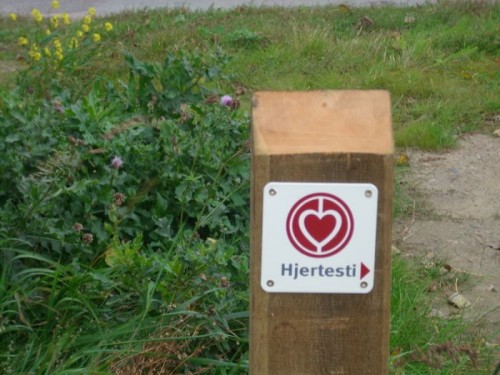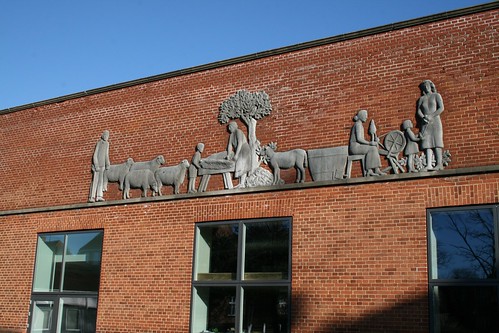Today is World Heart Day – be good to yours 🙂
At the heart of Sonderborg there is a marked 5km looped walking path. The path is named and labeled Hjertestien and is part of a network of walking routes across Denmark sponsored by the Heart Foundation (Hjerteforeningen), a non profit organisation that creates awareness and funds research regarding heart diseases.
The Heart Foundation recommends that you do at least 30 min of exercise a day and the Heart Paths network is an attempt to get more people out and walking.
The Sønderborg route officially starts at the church and goes clockwise around town but you can of course start anywhere.
View Hjertestien Sønderborg in a larger map
The municipality has created a map and folder in Danish about the path that you can find at the library and tourist information. We’ll provide an abbreviated translation here.
Church Square and Kirke Allé
At the northern corner of the church square is a big memorial from 1923 with the names of the 192 citizen of Sonderborg who died in WW1. Behind it a set of stairs lead up to Kirke Allé in the shade of the many liden trees from the church yard. This neighbourhood is from the period when the town was German from 1864 to 1920. Continue along the path across Lerbjerg.
Mølledammen
Mølledammen (The Mill Pond) is a natural lake with it’s reeds and rushes and trees overhanging the lake. On the grass there is a bronze sculpture by Poul Hansen called Children. Continue along Damgade across the intersection with the modern sculture Knuden (The Knot) by Søren Møller.
Kongevejsparken
Standing on the steps leading to the park from Smallegade you will see where a hospital was from 1894 to 1975. Several of the trees in the park were part of the hospital garden. As you walk through the park you will pass remains of a German rampart called Festung Sonderburg-Düppel that was built around 1865-66. From the park the path continues towards the Ahlmannsvej Neighbourhood. The green wedge between the villas on Ahlmannsvej og Kongevej is the path of the now defunct railroad that went from Sonderborg to Mommark.
Ahlmannsvej Neighbourhood
The neighbourhood here was created after the first city plan for Sønderborg from 1906 with the curvy roads inspired by English garden city ideals. At the east side of Ahlmannsvej the view is dominated by housing for the workers of that era in the shape of terraced houses in two floors. The west and south side is dominated by villas built after the style know as Bedre-Byggeskik.
On the wall of what used to be the biggest employer in Sonderborg, Det Nordiske Kamgarnsspinderi (The Nordic Yarn Factory) is a beautiful relief from 1943 by Victor Kvedéris
Continue across the ringrider grounds and past the stadium following Stadionstien to the Kurhusskoven.
Kurhusskoven
In 1877 a small forest was planted here along the water, outside of town along with a spa hotel as was the trend of that time. The heart path goes through the small patch of trees and along the promenade towards the castle.
Sønderborg Castle
This is where King Christian the second was held captive until 1549. Today the castle is a museum with interesting stories from the area.
Bjerggade and The Margarine Factory
Cut across the back of the castle and you get to Søndertorv with the statue of the ring rider made by Hans Pauli Olsen in 1998. walk across the square and head up the steep Bjerggade (Mountain street!). Here you will see examples of small houses built in the 17th century. Further on you get to a number of new residential blocks. Until 1998 this was the factory grounds of the margarine factory called Solo. Cutting through the new buildings is The Spanish Stairs. Once you make it to the bottom you can see a statue of a hand and a fish by Gunter Grass.
Monastery Stairs
The last part of the trip is along the pier, walk under the bridge, up the stairs back to the church. The uneven stones on Monastery Stairs unfortunately never lead to a monastery.
And that’s it. If you have made it this far you have walked a bit more than 5km and burned in the region of 350 calories. Do this a couple of times a week and your heart will ♥ you.




